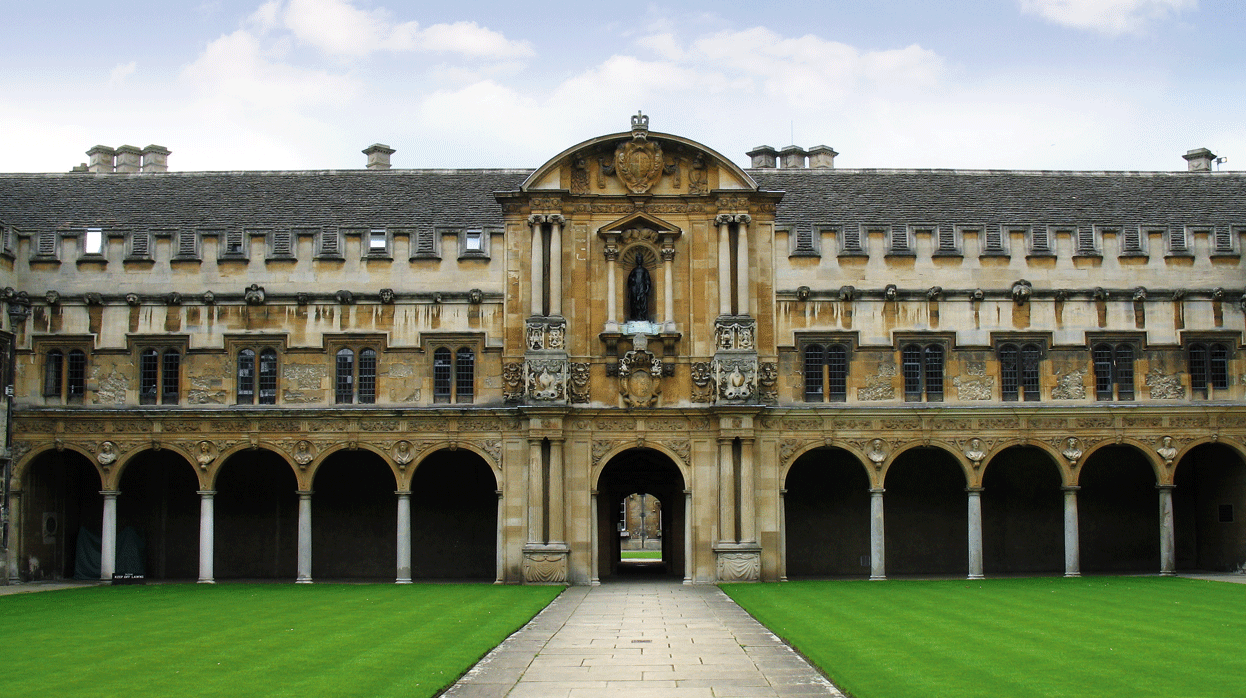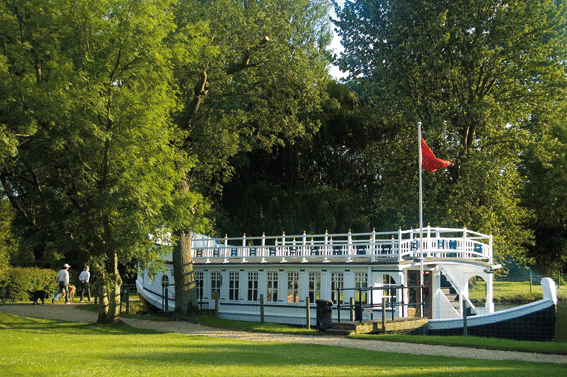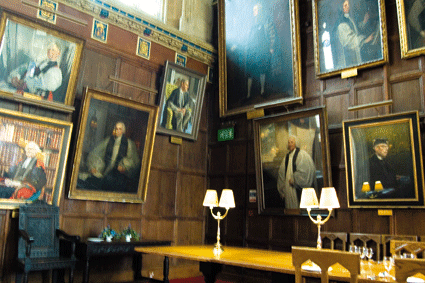

The Collegiate
Aspiration of Oxford
 |
The university town of Oxford with its 29 undergraduate colleges,
each with a history and style of its own, is Britain’s oldest seat of learning. It is also a busy county town,
attracting some ten million visitors a year to its many shops, museums and restaurants,
its river, gardens and meadows.
An easy day trip from London, this city of dreaming spires lies just one hour
by train west of the British capital.
By Veronica Maria Garbutt
When the noble River Thames flows through Oxford it is called the Isis. Another river flows into it called the Cherwell. Eights Week, the annual college regatta held at the end of May, is a colourful melee of oarsmen rowing their way to glory with bands of supporters cheering from waterside boathouses. And May Morning celebrations on May 1 are rounded off with a watery finale as exuberant students jump into the Cherwell for a ritual soaking.
The original settlement grew up in Saxon times around the confluence of the two rivers. At this point it was fordable by drovers and their oxen, hence the name Oxford. The university was never formally founded but developed gradually from the late 11th century CE. University College in the High Street was the first to be founded in 1249. Soon after Merton College followed in 1264 CE. As well as its medieval library with a priceless collection of manuscripts, Merton also boasts the university’s oldest quadrangle.
Today there are over thirty five Halls and Colleges. Each is autonomous, with its own statutes. The university consists of a federation of the colleges with additional laboratories, libraries and museums. The Oxford Union, now a world famous debating society, has launched many a career and has been regularly addressed by internationally famous personalities from Winston Churchill to Diego Maradona.
At the start of their three or four years as an undergraduate, students become members of a college. On average each college is about 350 strong and students earn their degree as part of one of eighteen faculties. As competition for jobs upon graduation increases each passing year, the academic traditions of the old days are upheld. The eight week terms are shorter than almost any other British university where they are generally ten, and an informal tutorial system whereby students spend just an hour a week with their tutor, is much less structured than elsewhere.
One of Oxford’s great pleasures is seeing the quads, halls and cloisters of its ancient colleges. Many operate restricted entrance and charge a small fee. If you can, seek out Christ church, known familiarly as “the house.” Its picture gallery has fine Renaissance paintings and drawings including works by Titian, Rubens, Reynolds, Michaelangelo, Van Dyck, Da Vinci and Gainsborough. And its dining hall proved a convincing set for Hogwarts Hall in the Harry Potter films.
From the Broadwalk nearby across the meadow lies Merton College, one of the town’s oldest. Its library in Mob Quad was built in the 1370s CE. Opposite Merton are Oriel and Corpus Christi, smaller colleges but no less ornate. Turn into High Street and you will happen upon Magdalen (pronounced´’maudlin’) Tower. Behind Magdalen College is The Grove, a pretty deer park and the Water Walks, a pastoral maze of garden and stream side pathways. Walking westwards along the High Street you will pass on the left the Examination Halls and on the right St Edmund Hall.
Further west along the High street are University College on the left and All Souls on the right. A winding stroll along Queens Lane will take you to the Venetian Bridge which links the old and new buildings of Hereford college. From here there is a great view of the round Radcliffe Camera, the former science library, now a reading room on the left, and Sir Christopher Wren’s Bodleian Library on the right.
Here the enclosed space of the Schools Quadrangle retains its 17th century CE majesty, while within more than 5 million volumes are housed along with 50,000 of the world’s most precious manuscripts. Peer through the entrance and you can see the vaulted chamber which appeared as Hogwarts Infirmary in the Harry Potter films.
Turn the corner into Broad Street and you’ll find Blackwell’s opposite. The bookshop’s basement with its three miles of shelves is almost as fabled as the university itself. On the same side of the street is Balliol where a small wooden board heralds the institution’s good claim to be the university’s oldest college. Adjacent is Trinity with its pristine lawns.
Like much modern architecture the city’s more recent colleges have their detractors as well as their supporters. Queen’s College has been compared with Starship Enterprise in the film Star Trek. St Catherine’s, founded in 1963 and designed by Danish architect Anne Jacobsen attracts criticism and praise in equal measure. But everyone seems to admire the most dreaming spires of Said Business School. The new building was completed in 2001 and the institution is one of the world’s top-ranking business schools. So if it is an MBA you are after, this is the place to apply.
If you are interested in museums you will be spoilt for choice. The Museum of Oxford on Blue Boar Street provides a logical and coherent account of the city’s history from prehistoric times to the industrial age. It includes reconstructions of Roman kilns, displays of Alice Liddell’s belongings, Alice-in-Wonderland activity packs for children and photos of car manufacturing at Cowley. Just a few steps away at the top of the High Street is Carfax Tower which gives the best overall view of Oxford and the surrounding countryside.
The Ashmolean Museum on Beaumont Street is the oldest public museum in Britain. Founded in 1683, it holds a superb collection of exhibits from Egyptian sarcophagi and superb Islamic ceramics to Italian Renaissance, Dutch still-life and French Impressionist paintings. After this it is a time-honoured tradition to enjoy afternoon tea at the Randolph Hotel opposite. Then take a stroll in the gardens of St John’s College nearby. Landscaped by Capability Brown, the gardens rival those of Trinity and Wadham as the prettiest in Oxford.
Behind on Parks Road is the University Museum, a treasure trove of mineral, entomological, geological and zoological displays. Other museums worth seeking out include the Museum of Modern Art, the Bate Collection of Musical Instruments and the Museum of the History of Science. West of the city centre on New Road lies Oxford Castle. The original wooden keep dates back to 1071 CE, but the present forbidding structure was built in the 19th century CE. Highly recommended is Oxford Castle unlocked, a tour led by actors in medieval costume. It includes a tour with lots of intriguing tales of life and death in the city led by actors in medieval costume and covers St Georges tower, the crypt, prison wing and the castle mound.
Opposite Magdalen college liee Botanic Gardens, founded as a physical gardens specialising in medieval plants in 1621 CE. Bounded by a curve in the Cherwell they provide a peaceful escape from the city centre. According to the superintendent whose title is Hortus Praefectus (Garden Monitor) “this is the world’s most compact yet diverse plant collection. A garden like this is not just a historical curiosity but a valuable resource too.” After strolling through the hothouse to the lush yet ordered riverside speciments he adds,” “Many medicines are still derived from plants. We have 8,000 species representing 90 per cent of the world’s plant families.”
The gardens are a good vantage point to watch the exertions of punters, skilled and unskilled alike. Punting is not just a spectator sport however, and for a taste (all too literal sometimes!) of Oxford’s rivers you must head for Magdalen Bridge or Salter’s Steamers at Boathouse Folly Bridge. Here you can hire punts (chauffeured or not) and rowing boats.
The Cherwell, though narrower than the Isis and therefore trickier to navigate, provides more opportunities for pulling to the side for a picnic, an essential part of the punting experience. Most of the other boats out on the river belong to the university rowing clubs which started in the early 19th century CE, when top hats were de rigeur.
Accommodation in Oxford is limited so be sure to book ahead. The aforementioned Randolph hotel is a city landmark and grand in style and tradition. Another elegant hotel beside the river is Oxford Thames Four Pillars (www.four-pillars.co.uk) situated on the outskirts. Along with riverside dining it boasts a handy health club with pool. En route from town you will pass by Oxford Central Mosque and Islamic Education Centre which opened in 2008 CE.
Malmaison hotel which occupies the former prison is the last word in chic boutique style (www.malmaison-oxford.com). If you are on a smaller budget check out Holiday Inn, located in a new development with a sports centre and pool, shops and restaurants (www.holidayinn.co.uk). And if you are watching every penny, there is always the Youth Hostel, one of England’s loveliest (www.yha.org).
Eating out is a subject dear to the hearts of students, denizens and visitors alike. Brown’s at the top end of St Giles, a brasserie with a Seventies style, is always bustling. Jericho Cafe, a relaxed neighbourhood place, is good for Arabic and eastern Mediterranean dishes such as mezze and Moroccan lamb. At the Head of the River you can enjoy hearty English fare such as roast beef while watching struggling punters go by.
For good value rustic Italian cuisine check out Jamie’s Italian and for Indian dishes 4,500 miles from Delhi is the place to go. Al Shami does excellent Lebanese food with the focus on fish dishes and charcoal grills. For something different visit Malmaison Brasserie, a stylish restaurant with Modern European cuisine executed with precision and care. Finally for grand old fashioned dining in a baronial style hall don’t miss the Randolph hotel Restaurant. Bon appetite!
There’s plenty of good shopping in Oxford. Check out the Oxford Galley for contemporary British arts and crafts and Fellows for Oxford memorabilia. Blackwell’s bookshop was founded in 1879 CE by Benjamin Blackwell. Development and expansion by family members has since created nine outlets carrying the name Blackwell’s selling everything from specialist travel books to sheet music and recordings available from the music shop in Holywell Street.
The High Street has retained much of its historical character with non-chain shops such as Reginald Davis (silver and jewellery), Plus Pens ( fine stationery), Sanders (fine prints and paintings) and Ede and Ravenscroft (tailors). Children will have a field day at Hoyles games and Puzzles at No 72. Also noteworthy for shoppers is the Covered Market, off the High street, which opened in 1774 CE. This shrine to gastronomy sells the finest meat, fish, cheese, fruit and vegetables.
From Oxford it is an easy 13 km drive to Woodstock to see the Baroque Blenheim Palace. Britain’s largest private house, Blenheim was the birthplace of Sir Winston Churchill and has over a hectare of natural style gardens designed by Capability Brown. After lunch at the charming Feathers hotel dining room be sure to visit the Oxfordshire county museum. Trains to Oxford run every half hour from London’s Paddington Station. And a cheap day return ticket offers a big discount on normal fares.